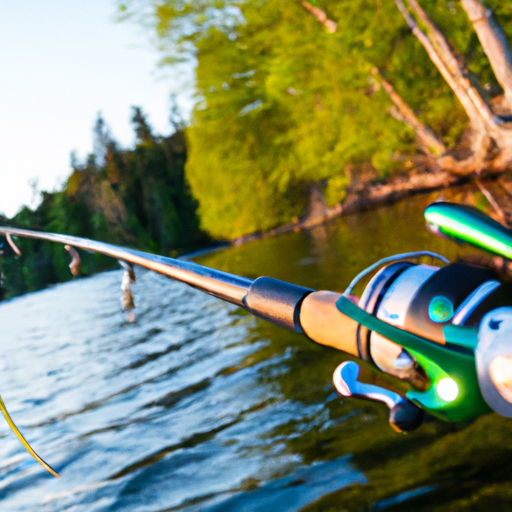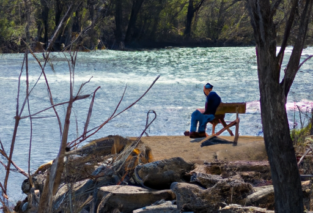Are you eager to cast your line and reel in some fish this spring? Look no further than “Can You Go Fishing In May: Spring Fishing Tips And Techniques.” Packed with expert advice and strategies, this comprehensive guide is your ticket to a successful fishing excursion in the month of May. Whether you are a beginner or a seasoned angler, this article covers everything you need to know to make the most out of your fishing trips this spring. From essential gear and bait selection to effective techniques and best fishing spots, “Can You Go Fishing In May” has got you covered. Get ready to enjoy a fruitful and memorable fishing experience this May with these invaluable tips and tricks!

Planning Your Fishing Trip
Researching the Fish Species
Before you set out on your fishing trip, it’s important to research the specific fish species that are abundant during the spring season. Different fish have different habits and preferences, so understanding their behavior and feeding patterns will greatly increase your chances of having a successful fishing experience.
For example, during the spring, bass are known to migrate to shallower waters to spawn, making them easier to catch. Trout, on the other hand, prefer colder water temperatures and can often be found in rivers and streams. By doing your research, you can identify the specific fish species you want to target and tailor your fishing strategy accordingly.
Checking Local Fishing Regulations
Before you start fishing, it’s crucial to check the local fishing regulations. Fishing regulations vary from place to place, and it’s important to respect and abide by them in order to protect the fish population and ensure a sustainable fishing environment.
Make sure to check the regulations regarding catch limits, size limits, and fishing seasons for the specific fish species you plan to target. Additionally, be aware of any protected or endangered species in the area and avoid fishing in designated protected zones. By understanding and following the local fishing regulations, you can enjoy your fishing trip while also helping to preserve the fish population.
Identifying the Ideal Fishing Spots
Once you have researched the fish species and checked the fishing regulations, it’s time to identify the ideal fishing spots for your trip. The success of your fishing trip greatly depends on choosing the right location.
Start by considering the type of water body you want to fish in. Lakes and reservoirs are popular choices for spring fishing, as they often have a variety of fish species and offer ample fishing opportunities. Rivers and streams are also great options, especially for trout fishing. If you prefer coastal or ocean fishing, consider checking out areas known for their abundance of fish during the spring season.
Research online, talk to local anglers, or consult fishing guides to find the best fishing spots in your chosen location. Look for areas with underwater structures, such as submerged rocks and fallen trees, as these can attract fish. Additionally, pay attention to the water depth and clarity, as these factors can also impact fish behavior. With careful research and planning, you can ensure that you choose the ideal fishing spots for your spring fishing trip.

Preparing Your Fishing Gear
Inspecting and Cleaning Your Equipment
Before you embark on your fishing trip, it’s essential to inspect and clean your fishing gear. This ensures that your equipment is in optimal condition and ready to be used.
Start by thoroughly inspecting your fishing rods and reels for any signs of damage or wear. Check the guides, eyelets, and handles for any cracks, chips, or loose parts. Replace or repair any damaged components to avoid any potential issues while you’re out on the water.
Next, clean your fishing reels to remove any dirt, saltwater residue, or debris. Use a reel cleaning solution or a mixture of warm water and mild detergent to gently clean the reel. Pay special attention to the drag system and the line roller, as these are areas where dirt and grime can build up.
Inspect and clean your fishing lines as well. Check for any frays, knots, or weak spots. If you notice any issues, it’s best to replace the line to avoid any problems while fishing.
Finally, make sure to organize your tackle box and replenish any essential items such as hooks, sinkers, and swivels. Having a well-stocked and well-organized tackle box will save you time and frustration when you’re out on the water.
By inspecting and cleaning your equipment before your fishing trip, you can ensure that everything is in working order and increase your chances of having a successful and enjoyable fishing experience.
Stocking Up on Bait and Lures
Having the right bait and lures is crucial for attracting fish and enticing them to bite. In the spring, fish are often more active and hungry as they prepare for spawning, making it the perfect time to experiment with different bait and lures to see what works best.
Live bait such as worms, minnows, or insects can be highly effective for many fish species. They provide a natural scent and movement that can be irresistible to fish. Make sure to properly store and keep your live bait fresh to maintain its effectiveness.
Artificial lures, including crankbaits, spinnerbaits, and soft plastic baits, can also be successful during the spring. Opt for lures that imitate the natural prey of the fish species you are targeting. For example, if you’re fishing for bass, consider using lures that resemble small fish or frogs.
It’s a good idea to have a variety of bait and lures on hand to adapt to different fishing conditions and fish preferences. Experiment with different colors, sizes, and patterns to see what works best for you. Don’t be afraid to try new techniques and switch things up if one type of bait or lure isn’t yielding results.
Testing and Replacing Fishing Lines
Fishing lines can become weak over time due to exposure to sunlight, water, and wear from fish bites and friction. Before your spring fishing trip, it’s important to test and replace your fishing lines if necessary.
Start by checking the condition of your fishing lines. Look for any signs of fraying, discoloration, or weak spots. Run a few feet of line between your fingers to feel for any roughness or abrasions. If you notice any issues, it’s best to replace the line to avoid any potential breakage while you’re fishing.
Consider the type of fish you will be targeting and the fishing conditions you expect to encounter. Different fish species and fishing techniques may require different types and strengths of fishing lines. Consult with local anglers or fishing experts to determine the most appropriate fishing line for your needs.
Once you have replaced your fishing lines, it’s a good idea to test them before your fishing trip. Attach a weight to the line and give it a few strong tugs to ensure that it can withstand the pressure. This will give you peace of mind and prevent any surprises while you’re out on the water.
By inspecting, replacing, and testing your fishing lines, you can ensure that they are strong and reliable, increasing your chances of successfully landing the fish you hook.

Mastering the Spring Fishing Techniques
Understanding the Behavior of Spring Fish
Spring is a unique time for fish, as they undergo various changes in behavior due to spawning and feeding patterns. Understanding these changes is key to mastering your spring fishing techniques.
During the spring, many fish migrate to shallower areas to spawn. They become more active and aggressive, making them easier to target. They may also be more willing to strike at different baits or lures. It’s important to learn about the specific fish species you’re targeting to know when and where they spawn, as well as their preferred water temperatures and habitats.
Additionally, spring fish are often feeding more actively in preparation for spawning. They may be more receptive to a wider range of baits and lures. Experiment with different types and sizes of bait to see what triggers their feeding response. Observe their behavior and adjust your techniques accordingly.
Using Different Baits and Lures
Spring fishing provides an opportunity to experiment with different baits and lures to find what works best for the fish species you’re targeting. As fish become more active and hungry, they may be more willing to bite on a variety of offerings.
When using live bait, consider using worms, minnows, or insects that are naturally found in the water during the spring. These can be highly effective in attracting fish and triggering their feeding instincts. Pay attention to the movement and presentation of the bait, as fish may be attracted to the natural motion.
Artificial lures can also be successful during the spring. Crankbaits, spinnerbaits, and soft plastic baits can mimic the movement and appearance of fish or other prey. Choose lures that closely resemble the natural food sources of the fish species you’re targeting. Vary the speed and depth of your retrieve to determine what triggers the most strikes.
Adopting Different Fishing Techniques
In addition to using different baits and lures, it’s important to adopt different fishing techniques during the spring to increase your chances of success. Experiment with different techniques to find what works best for you and the fish you’re targeting.
Casting and retrieving is a common technique that can be effective in covering a lot of water and enticing fish to strike. Vary the speed and depth of your retrieve to find the most productive combination. This technique works well with both live bait and artificial lures.
Drift fishing is another technique that can be effective, particularly in rivers and streams. Allow your bait or lure to drift naturally with the current, presenting it in a way that is appealing to the fish. Adjust your weight or sinker to control the depth and speed of your drift.
Trolling is a technique that involves dragging bait or lures behind a moving boat. This can be effective for covering large areas of water in lakes or reservoirs. Vary your trolling speed and consider using attractants or scent to increase your chances of attracting fish.
By adopting different fishing techniques and experimenting with various baits and lures, you can increase your chances of enticing fish to bite and improve your overall fishing success during the spring season.

Discovering Top Spring Fishing Locations
Exploring Lakes and Reservoirs
Lakes and reservoirs are popular fishing destinations during the spring season. They offer a wide range of fish species and varied fishing opportunities. It’s important to explore different areas of the lake or reservoir to find the best spots for your fishing trip.
Begin by researching the specific lake or reservoir you plan to fish in. Look for areas with favorable conditions for fish, such as underwater structures, vegetation, or deeper channels. These features can attract fish and provide them with food and shelter.
Consider the time of day and weather conditions when choosing your fishing spots. Fish are often more active during early morning or late evening, so targeting these timeframes can increase your chances of success. Pay attention to wind direction and water temperature, as these factors can impact fish behavior and location.
Boat fishing can be particularly effective in lakes and reservoirs, as it allows you to cover larger areas of water and access fish-holding structures. Use a fishfinder or sonar to locate underwater structures and schools of fish. Drift fishing or trolling can be effective techniques in these larger bodies of water.
Finding Rivers and Streams
Rivers and streams are another popular choice for spring fishing, particularly for trout and other freshwater species. These flowing bodies of water provide an ideal habitat for fish and offer unique fishing challenges.
When fishing in rivers and streams, it’s important to study the water currents and structures. Look for areas where the current slows down or changes direction, as these are often prime feeding spots for fish. Rocks, fallen trees, and deeper pools can also attract fish and provide cover.
Consider using wading techniques when fishing in rivers and streams. This allows you to get closer to the fish and make more accurate casts. Be cautious of the water level and currents, and always wear proper safety gear, such as wading boots and a wading belt.
Fly fishing is a popular technique in rivers and streams, particularly for trout. It involves using lightweight artificial flies to mimic natural insects or other prey. The flowing water provides a more realistic presentation, making it appealing to fish. Practice your casting technique and experiment with different fly patterns to find what works best for the fish in your chosen river or stream.
Checking out Coastal and Ocean Fishing
For those who prefer saltwater fishing, the coastal and ocean areas offer abundant opportunities during the spring season. From shore fishing to offshore fishing, there are many options to explore.
Shore fishing allows you to fish directly from the coastline, jetties, or piers. Research the specific coastal area you plan to fish in and look for potential hotspots. Search for areas where the waves break, as these can attract fish. Jetty structures can provide additional fishing opportunities, as they create currents and eddies that fish often inhabit.
Boat fishing in coastal and ocean areas allows you to access deeper waters and target larger game fish. Consider hiring a charter boat or bringing your own vessel if you’re an experienced boater. Consult with local captains or fishing guides to find the best spots for the fish species you’re targeting. Deep-sea fishing can be particularly exciting, as you have the chance to catch trophy-sized fish such as tuna, marlin, or swordfish.
Research the local fishing regulations for coastal and ocean areas, as they may have specific restrictions or catch limits. Additionally, be aware of weather conditions, tides, and potential hazards such as rip currents or strong winds. Safety should always be a priority when fishing in open waters.
By exploring lakes and reservoirs, rivers and streams, as well as coastal and ocean areas, you can discover a variety of top spring fishing locations and increase your chances of catching a wide range of fish species.






